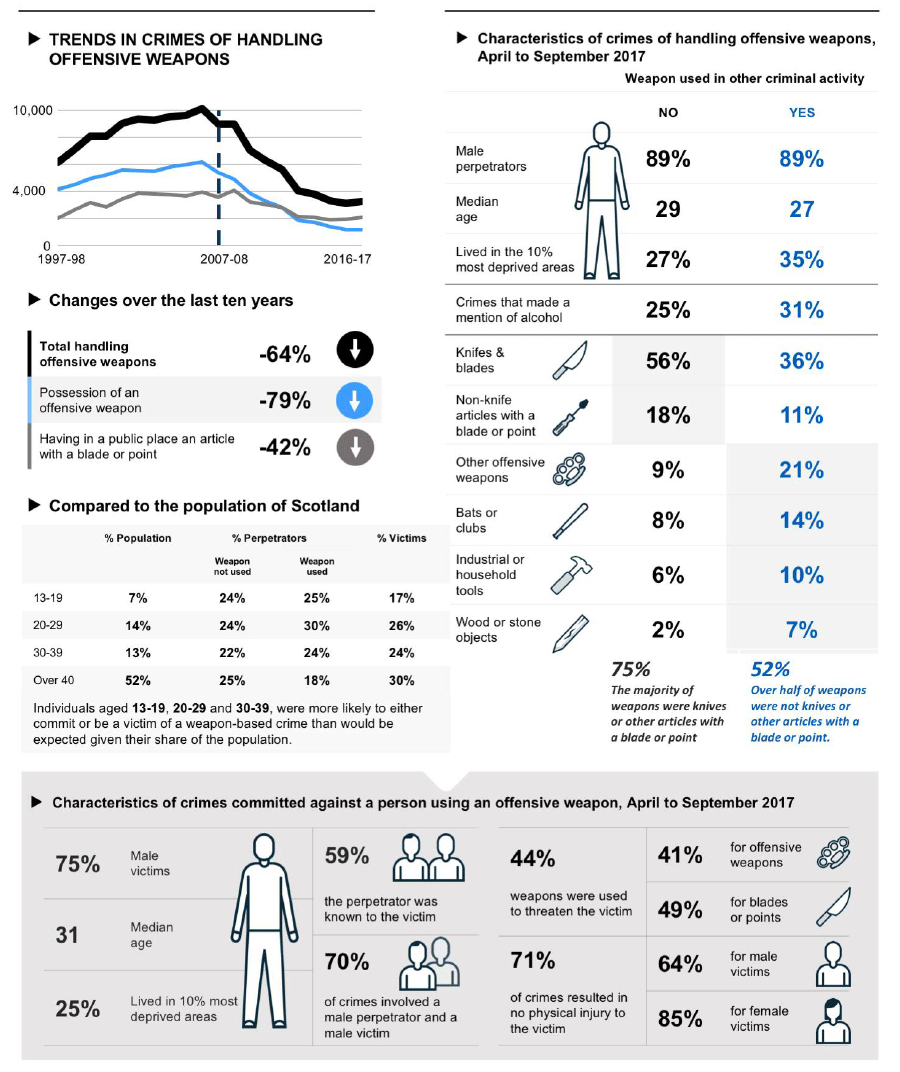Recorded crime in Scotland: handling offensive weapons
This report presents information on handling offensive weapons recorded by the police.
Executive summary
This report presents information on the handling of offensive weapons within public places in Scotland. This includes new details on the characteristics of these cases, based on a random sample of police recorded crimes.
Key Findings
The main sources of evidence all point to a substantial and long term reduction in the handling of offensive weapons in Scotland over the past decade.
As fewer cases of handling offensive weapons were being recorded by the police, resulting in fewer convictions – both the number of adults who believed knife carrying was common in their local area and the number of emergency hospital admissions due to assault with a sharp object also fell.
Over time, the vast majority of those convicted of handling an offensive weapon remain male but by 2016-17 they were older than their counterparts 10 years earlier (with their median age increasing from 24 to 29 years old).
Based on a random sample of police recorded crimes from April to September 2017
The overwhelming majority of police recorded crimes for handling an offensive weapon in a public setting were committed by males (89%). The median age of a perpetrator was 29 years old when the weapon wasn’t used in other criminal activity, this is slightly older than in 2013 when the median age was 27. When the weapon was used in other criminal activity the median age was 27.
Between 2013 and 2017, where the weapon was not used in other criminal activity, there was a decrease in the proportion of perpetrators aged between 20 and 29 (from 34% to 24%) and an increase in those aged 40 or over (from 19% to 25%). Individuals aged 13 to 19, 20 to 29 and 30 to 39 were more likely to be found in possession of an offensive weapon than expected from their overall share of the population. This is the case whether the weapon was used in other criminal activity or not.
Almost a fifth (17%) of all victims were teenagers (i.e. aged between 13 and 19). Over a quarter (26%) were aged between 20 and 29 with further 24% aged between 30 and 39 and 30% aged 40 or over. Individuals aged 13 to 19, 20 to 29, and 30 to 39 are more likely to be victims of a weapon-based crime than would be expected given their share of the population as a whole.
Three-quarters of criminal acts involving the use of a weapon in a public setting had a male victim (75%). In 70% of all cases both the perpetrator and victim were male. Just under a fifth (19%) had a female victim and a male perpetrator. Victims of criminal acts involving the use of a weapon had an median age of 31 years old.
Perpetrators and victims were more likely than not to know each other (59% known compared to 41% not known). They were both more likely than average to live in urban areas and areas of higher deprivation.
The most common criminal act committed with a weapon in a public setting was threatening or abusive behaviour (44%), followed by common assault (32%) and serious assault (14%). Threatening or abusive behaviour was more likely to occur and serious assault less likely to occur when the victim was female, compared to male victims.
The majority of criminal acts committed with a weapon against a person in a public setting involved no physical injury to the victim (71%). This proportion was slightly higher when the weapon was a bladed or pointed article like a knife (74%).
In 29% of cases the victim of a weapon-based crime in a public setting sustained some degree of physical injury (including 26% of cases where the weapon was a bladed or pointed article and 31% for other offensive weapons).
When bladed or pointed articles were used against other people in a public setting, they caused a serious assault level injury in 21% of cases (such as stab wounds or other permanent disfigurement).
Criminal acts committed with a weapon against other people in public settings were more likely to involve no physical injury if the victim was female and if the victim did not know the perpetrator.
A person in possession of an offensive weapon whilst in a public place, school or prison, without reasonable excuse or lawful authority, is guilty of a crime under the Criminal Law (Consolidation) (Scotland) Act 1995. These findings relate to a sample of crimes recorded by the police under this act.

Justice Analytical Services
Contact
There is a problem
Thanks for your feedback